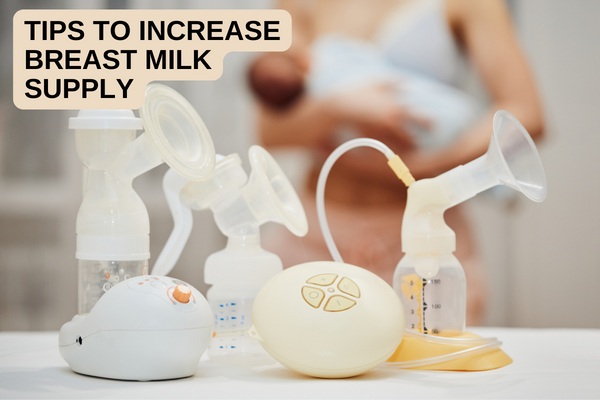“Even if a mother breastfeeds for just a few weeks after giving birth, she is giving her baby an enormous health boost with positive effects that can be seen almost immediately, as well as long- term benefits that may help her child remain healthier and clear into adulthood.”
– Audrey Naylor, MD. Paediatrician
Breastfeeding benefits both you and your baby. Breast milk is the perfect food for your baby, providing all the nutrients they need for healthy growth and development. Breastfeeding can also reduce your baby’s risk of infections, allergies, and chronic diseases. For mothers, breastfeeding can help promote postpartum recovery, reduce the risk of postnatal depression, breast and ovarian cancer, and strengthen the bond between mother and child.
Getting started with breastfeeding, however, can be challenging, especially for first-time moms. In this guide, we’ll share some strategies for new moms to initiate breastfeeding after birth and start their breastfeeding journey on the right foot.
Timely Initiation of Breastfeeding
Initiating breastfeeding within the first hour after birth, also known as the golden hour, is crucial for both the mother and the baby. During this time, babies are usually wide awake and eager to nurse, making it the perfect time to introduce breastfeeding. In fact, babies have an innate ability to find their way to their mother’s breast and start suckling within minutes of birth. This contact triggers the release of oxytocin, which stimulates milk production and helps establish a special bond between mother and baby. At this time the baby could even get its first feed of colostrum which will provide it with a boost of immunity. Initiating breastfeeding within the first hour after birth can play a pivotal role in establishing a successful breastfeeding relationship in the longer term.
Benefits of breastfeeding at birth
According to WHO and UNICEF, initiating breastfeeding within the first hour has many benefits for both mother and baby, such as:
- Stimulating the production of breast milk and helping prevent engorgement.
- Promoting skin-to-skin contact and enhancing bonding between mother and baby.
- Helping the uterus contract and reducing postpartum bleeding.
- Protecting the baby from infections and allergies by providing colostrum, the first milk that contains antibodies and other protective factors.
- Supporting exclusive breastfeeding for the first six months of life, which is recommended by WHO and UNICEF for optimal growth, development and health of infants.
- Reducing the risk of newborn death by up to 22%.
Preparing for Breastfeeding at birth
If possible, choose a hospital or birth setting and a care team that has a supports early initiation of breastfeeding. A lot of hospitals and birth centers now have practices and standard processes that will help you and your baby be successful with breastfeeding starting with skin-to-skin and first feed in the delivery room. Ask about these practices during your hospital tour and selection phase.
New mothers often have a tough time with breastfeeding. The tiredness and all the activity that sets in after delivery add to the challenges. You can make this smoother by creating a breastfeeding plan. It is a plan of action that outlines your desired breastfeeding experience and breastfeeding goals for right after giving birth. Involve your partner in the planning process so that you can rely on their support during crunch time. Once the plan is ready, share it with the hospital staff, doula and your birthing partner/birthing support team. This plan should detail what you want to happen right after the baby’s birth.
Additionally, going through a prenatal breastfeeding class or seeking the advice of a lactation consultant before giving birth can help you feel more confident about breastfeeding. So consider adding a lactation coach to your pregnancy support team and not just your postnatal team. If you are looking to hire a doula, ask the doula if she can help with breastfeeding advice.
How to initiate Breastfeeding right after birth
Ask for immediate skin-to-skin contact with your baby after delivery, unless there are medical reasons to separate you. Skin-to-skin contact immediately after birth increases the chances of exclusive breastfeeding, as it helps regulate your baby’s temperature, heart rate, and breathing and helps the baby feel secure and warm. It facilitates the release of oxytocin and promotes bonding between you and your baby.
Keep your baby close to your chest until he or she shows signs of readiness to breastfeed, such as opening their mouth or turning their head towards your breast. There are several positions you can try when initiating breastfeeding. It’s important to find a position that is comfortable for both you and your baby, and to make sure your baby’s head and body are in a straight line.
Additionally avoid any interventions that may interfere with early initiation of breastfeeding, such as routine suctioning, bathing, weighing or measuring your baby before they have breastfed. Delay these procedures until after the first feed or do them while keeping your baby skin-to-skin with you.
The role of the birth partner is also crucial in supporting breastfeeding initiation. Your partner can help position the baby for optimal latch, and provide emotional support and encouragement
Overcoming Common Challenges in Breastfeeding Initiation
Breastfeeding initiation can be challenging for some new moms, and it’s important to be aware of common issues that may arise. Delayed or interrupted skin-to-skin contact, cesarean birth, nipple pain or soreness, and lack of knowledge or advice are some of the challenges that new moms may face. However, with proper support and guidance, these challenges can be overcome.
If you had a cesarean birth, you can still initiate breastfeeding by having skin-to-skin contact as soon as possible and finding a comfortable position to breastfeed in. Seeking information and advice early and in the preparation stage will set you up to tackle these challenges with confidence.
Breastfeeding in the first few days
The first few days of breastfeeding experience are a critical component of a successful breastfeeding journey. Usually hospitals have nurses and lactation consultants that are available to offer guidance and assistance making it a perfect time for new mothers to learn about latching, positioning, and milk production. The first couple of days of breastfeeding in the hospital allows mothers to learn some basics of breastfeeding in a hands-on manner and establish their milk supply.
Take advantage of the resources available in the hospital to help you start your breastfeeding journey.
- Identify a lactation coach at the hospital that you could seek help/advice from
- Ensure your baby sleeps in the same room as you
- Breastfeed your baby on demand, whenever they show signs of hunger or interest in feeding. This may be as often as every hour in the first few days. Remember, babies have small stomachs and need to feed frequently. Putting your baby to the breast every few hours will also stimulate milk production and help you build your milk supply.
- Avoid giving any other foods or liquids to your baby during this time, including water, formula or pacifiers. Supplementation can interfere with the natural process of breastfeeding. Inform the hospital that you wish to breastfeed exclusively, no supplements unless necessary and that you wish to avoid using soothers.
- Use a breast pump if you are unable to breastfeed your baby directly.
- Monitor your baby’s feeding patterns and output (wet diapers and stools) to ensure they are getting enough milk. By day five your baby should have at least six wet diapers and three yellow stools per day. You could track this in an app, on your phone or in a diary.
- Seek help from the lactation coach if you need guidance on how to position and latch your baby onto your breast or if you have any concerns about your milk supply or your baby’s weight gain.
- Learn the techniques of breast massage, this will help avoid engorgement. Learn about the various breastfeeding positions and basic breastfeeding techniques. Getting these basics right can go a long way in establishing breastfeeding.
In this video, you will learn about 5 tips for successful Breastfeeding:
Conclusion
Initiating breastfeeding early can make a big difference in your breastfeeding experience and your baby’s health. Remember that you are not alone in this journey – there are many resources and support groups available online or in person to help you overcome any challenges along the way. For more on breastfeeding read our other blog post containing tips for successfully breastfeeding.
At Veira we have coaches that are certified lactation counsellors and can help you as you establish and continue breastfeeding. If you have questions or are struggling with breastfeeding issues, book a call with a Veira Coach for breastfeeding support and professional advice.
We also have an online course “Guide to Breastfeeding” which covers the basics of breastfeeding, the common issues breastfeeding moms encounter. It is packed with resources such as videos, breastfeeding plan template, trackers, checklists, shopping lists etc. to help you plan for, establish and continue with breastfeeding successfully.
Happy Breastfeeding!







